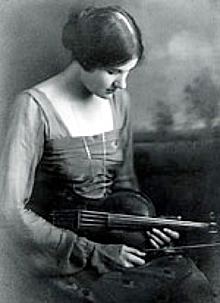|
Viola Sonata (Rebecca Clarke)
Rebecca Clarke composed the Sonata for Viola and Piano in 1919,[1] when the composer was 33 years old. She had been supporting herself with some success as a soloist. The majority was composed between April and July 1919. CareerThe first reference to the Viola Sonata was upon its submission to a composition competition sponsored by Clarke's neighbour, Elizabeth Sprague Coolidge.[2] Out of 72 entries, Clarke's Sonata tied for first with a piece by the Swiss composer Ernest Bloch. In the end Bloch was declared the winner, despite all the judges favouring Clarke—it was decided that declaring Clarke the winner would smack of favouritism on Coolidge's part. Clarke later said in an interview that she remembered a critic speculating that "Rebecca Clarke" was the pen-name of a male composer, as they could not imagine the possibility of a competent woman writing such music.[citation needed] PremiereThe piece had its première at the Berkshire Music Festival in 1919, and was well received. It, along with the Piano Trio of 1921 and the Rhapsody for cello and piano of 1923, represent the zenith of her compositional career. The sonata was first published in 1921 by Chester Music.[3] Clarke gives us an incipit on the first page of the sonata, a quote from La Nuit de mai (1835) by the French poet Alfred de Musset:
The sonata is cast in three movements.
Because of the many different obstacles the piece presents, as well as its highly idiomatic writing, it is becoming more and more a staple of the violist's repertoire.[4] OrchestrationThe Rebecca Clarke Society commissioned an orchestration of the Viola Sonata from composer Ruth Lomon. It was premiered in 2007 by violist Peter Sulski. Subsequent performances have featured soloists Esra Pelivahnli, Catherine Hanson, and Melissa Matson. References
Journal
Book
External links
|
||||||||||||||||||
